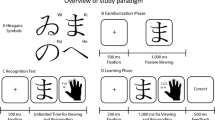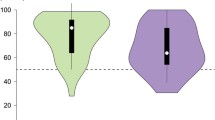Abstract
A study of visual discrimination learning is described comparing 20 autistic children with 20 suffering Down's syndrome and 20 normal controls. The subjects, all boys, were trained to discriminate between two visual stimuli varying in color, form, and size. They were then tested on the three parameters presented separately and in combinations of two. It was found that normal children and those who were classified as verbal autistic did not differ in overall performance or in the effective use of double cues, but were superior to retardates, and retardates were superior to nonverbal autistic children. There was no cue dominance in normal, verbal autistic, and retarded children, but size and color were significantly preferred to form by the nonverbal autistic group.
Similar content being viewed by others
References
Bryson, C. Q. Short-term memory and cross-modal information processing in autistic children.Journal of Learning Disabilities, 1972,5, 81–91.
Eimas, P. D. Components and compounds in the discrimination learning of retarded children.Journal of Experimental Child Psychology, 1964,1, 301–310.
Eimas, P. D. Multiple-cue discrimination learning in children.Psychological Record, 1969,79, 417–424.
Hermelin, B., & O'Connor, N.Psychological experiments with autistic children. London: Pergamon Press, 1970.
House, B. J., & Zeaman, D. Miniature experiments in the discrimination learning of retardates. In L. P. Lipsitt, & C. C. Spiker (Eds.),Advances in Child Development and Behavior. Vol. 1. New York: Academic Press, 1963.
Kendler, H. H., & Kendler, T. S. Vertical and horizontal processes in problem solving.Psychological Review, 1962,69, 1–16.
Koegel, R. L., & Wilhelm, H. Selective responding to multiple visual cues by autistic children. Unpublished manuscript, University of California, Santa Barbara, 1972.
Lovaas, O. I., Schreibman, L., Koegel, R., & Rehm, R. Selective responding by autistic children to multiple sensory input.Journal of Abnormal Psychology, 1971,77, 211–222.
Rimland, B.Infantile autism. New York: Appleton-Century-Crofts, 1964.
Rutter, M., & Bartak, L. Causes of infantile autism: Some considerations from recent research.Journal of Autism and Childhood Schizophrenia, 1971,1, 20–32.
Siegel, S.Nonparametric statistics. New York: McGraw-Hill, 1956.
Skinner, B. F.The behavior organisms: An experimental analysis. New York: Appleton-Century-Crofts, 1938.
Warren, J. M. Additivity of cues in visual pattern discriminations by monkeys.Journal of Comparative and Physiological Psychology, 1953,46, 484–488.
Warren, J. M., & Harlow, H. F. Learned discrimination performance by monkeys.Journal of Comparative and Physiological Psychology, 1952,45, 119–126.
Zeaman, D., Thaller, C., & House, B. J. Miniature experiments in the discrimination learning of retardates. In L. P. Lipsitt, & C. C. Spiker (Eds.),Advances in child development and behavior. Vol. 1. New York: Academic Press, 1963.
Zeaman, D., Thaller, C., & House, B. J. Variability of irrelevant stimuli in discrimination learning of retardates.Journal of Experimental Child Psychology, 1964,1, 84–98.
Author information
Authors and Affiliations
Additional information
Computer support for this research was obtained from NIMH Grant MH-06645-11, principal investigator Kenneth Mark Colby, Senior Research Associate, Department of Computer Science, Stanford University.
This research was originally presented as a master's thesis to San Francisco State University by Patricia Kovattana. Requests for reprints should be sent to Patricia Kovattana, 535 15th Avenue, Menlo Park, California 94025.
Rights and permissions
About this article
Cite this article
Kovattana, P.M., Kraemer, H.C. Response to multiple visual cues of color, size, and form by autistic children. J Autism Dev Disord 4, 251–261 (1974). https://doi.org/10.1007/BF02115231
Issue Date:
DOI: https://doi.org/10.1007/BF02115231




